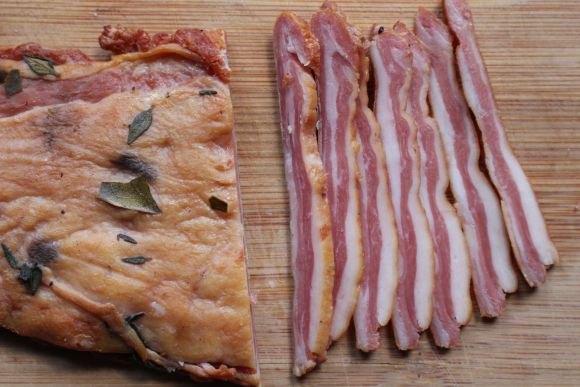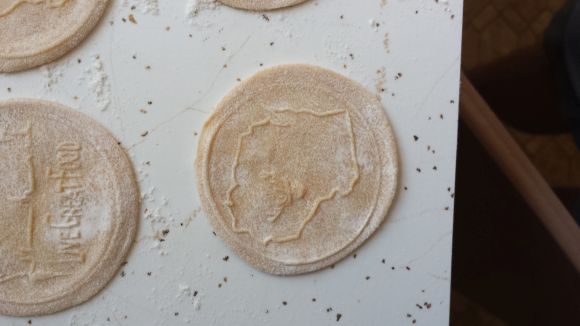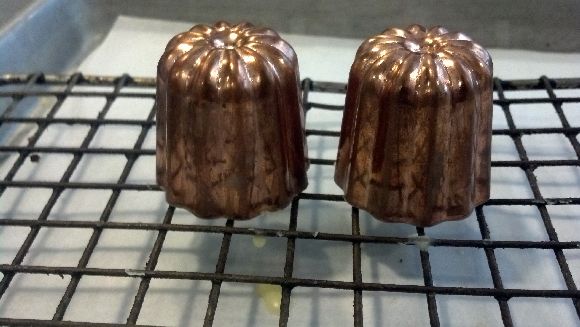
Butcher’s Cut: Lamb Bacon
“Tell me what you eat and I shall tell you what you are.”
–Jean Anthelme Brillat-Savarin
Years ago, I set out to connect to the food I was creating. I found peace in a slaughterhouse. Perfect practice, process, technique, execution, craft, traditionalism, legacy, and a beautiful respect in life and death. This was something of a new rabbit hole, many of the same standards of execution found in a kitchen; yet it somehow had more of a spirituality to it. Instead of cutting a steak out of a cryovac bag and seasoning it for the grill, I came eye to eye with with the animals I would be taking that steak from.There is a respect in knowing your livestock, it becomes more personal. There was an enormous sense of obligation and pressure once I learned to carve a carcass. It was always life or death if I fumbled or hesitated in making a cut, quite literally. If I made the wrong cut or completely botched a primal, please understand each animal is made up of just two halves. If I needed two whole tenderloins off of the animal to fill a customer’s request; I knew a second animal was headed to slaughter later in the week to fix my mishap. You learn anatomy real fast when you are first thrown onto a cutting table. You find yourself facing remorse and empathy as you watch an animal walk the kill shcute because of the direct effects of your skillset. In a kitchen, you are not always faced with your shortcomings.

Everything is different, yet could not be more identical when comparing a kitchen to a butcher shop. There are still customers, yet the way you interact with the customer has changed. There is still food, but the foods you create are unfinished. There is the same bravado or pride I have discovered in kitchens amongst many of the butchers I have come into contact with over the years; but even that differs. In a butcher shop you do not find much ego, rather a noble belief that as a butcher, you live a “High Life.” Butchers believe that they are eating the finest parts of the animal because the rest of the world has forgotten about those cut’s. In all honesty, I have no argument suggesting otherwise. I have worked in restaurants in which I have sold 6 ounces of quality lamb, always the chop (because that’s what sells), pasture raised and well fed, fetching $35-45 a plate. It is heralded as a great dish… It, not bad, but In my eye it is the equivalent of the “Campbell’s Soup Cans” collection by Andy Warhol…I mean, yeah, technically it is a great form of “art”… But, is it? At face value, it’s a painting of a soup can; he didn’t even create the logo. In the same spirit, It’s a lamb chop; they’re good but they are far from the best part of the animal. I’d take a neck over a rack anyday, perhaps I’m too simple to understand the intricacies of Fine Art… Yet somehow still the word “neck” is a hard sell on a menu. It identifies the part of the animal you are eating. It is then at that moment the consumer remembers Shari Lewis & her sock puppet and how they grew up on PBS and how dare you eat Lamb Chop’s neck… It’s a slippery slope; I fully acknowledge that we have come back around and made large strides reintroducing butchery to our menus in recent years but let us not to forget the hustle and tribulations that got us here.

People are constantly redefining what it means to eat righteously. With a world of opinions out there; it is easy to offend someone if not a whole group of someone’s who eat “better” than you with less guilt and murder and these people simply cannot hold their tongue. It begins to create a snowball effect in which we shy away from associating with our foods. We stop paying attention to how the process works. We stop caring about how that process effects us physically. It becomes complicated when someone eats meat, but doesn’t know what A lamb looks like… Or another person diets for months on end, eating nothing but Tyson chicken and never come away with desirable results.
Perhaps, it has become too complicated. Maybe we need to simplify. Revisit the old idea that “you are what you eat”(paraphrased) famously introduced by a gourmand that pops up across nearly every present day butcher shop or in the books pertaining to the subject of butchery; Jean Anthelme Brillat-Savarin. A man of many words and butchers have comfortably resonated. Seemingly, unanimously as an industry, butchers have bought in whole hearted. Brillat-Savarin has created a cult following with his infamous opinions, rather brazen yet precise proclamations pertaining to food. At some point through his tome, The Physiology of Taste, the Author captured the idea of praising the delicacies and finding a comfort (if not a swag) in appreciating the rarities. This is a religious belief found widely throughout butcher shops; the idea of a heightened palate, the ability to truly appreciate the finer things. This appreciation is an essential building block in the ideology that supports whole animal cookery. Having that said, we will now turn our attention to the Lamb.
Anatomy 101: An Education in Lamb

Lamb refers to a variety of Sheep slaughtered prior to 12 months old when the flesh and meat are still delicate. Between 12-24 months you will have the juvenile sheep referred to as a yearling or hogget; Anything beyond 24 months is typically referred to as Mutton. All stages have their own praises and faults; highly subject to preference in taste. This is a topic for another time. The diagram Above is a sketch that I believe optimizes the full potential of the carcass in many different presentations leaving very little waste. It is a combination of techniques taught to me while in the Wisconsin Northwoods by a couple of men in different shops with the same mission; maximum yield and value added. I use this diagram in my butchery classes as a hard copy resource reiterating that nothing beats the hands on understanding. Here is one of our recipes that allows you rethink the use of the Bellies, Cleaned Brisket & Breasts and even the deboned Ribs.

There are a number of recipes and cuts that would fall into the category of Delicacies; but in the spirit of starting small we will begin with something easily digestible and rather familiar.Lamb Bacon! this is a recipe that shows the flexibility of a lamb belly in a familiar process of preservation. In the old days, preserving meat was a necessity. A way of slowing down spoilage after slaughter when refrigerated was limited and we did not have the pleasure of picking and choosing what parts of the animal we took. Bacon is THE premier choice process with a traditionalism of it’s own that has forever captured our hearts and never let us down.
Lamb Bacon Recipe:
Step 1:
When Breaking down the Lamb Carcass; Make Sure to make long intentional cuts. Use a sharp knife and avoid making hundreds of slices into the flesh when deboning or cleaning; all this dose is create a larger surface area exposed to bacteria and gives it a perfect little nook to manifest and procreate leading to spoilage in your meat in no time. Long Clean Cuts, following the natural separation of the animal’s muscles.
Step 2: Collecting The Cure
5 oz Sea Salt
1 tsp Pink Salt
3oz Brown Sugar
1 oz Honey
1 Tsp Black Peppercorn
1 Star Anise – Broken up
1 tsp Crushed Red Pepper
3 Bay Leaves – Crushed
5 Sprigs Fresh Thyme
2 Cloves Garlic – Crushed
Combines all of the ingredients in a large bowl and mix thoroughly, making sure to disperse the ingredients evenly. *note, these spices area personal preference, you are able to adjust the spices and the flavors any way you seen fit. just note quantities and adjust accordingly. I.e. don’t add a cup of cloves… because that would taste terrible.
Step 3: In the Bowl, I like to toss the bellies with the cure. This ensures they coat evenly. I had roughly 5 lbs of Lamb that I was going to use for this batch of bacon and the cure was more than enough for this job. you want to cover the lamb completely.

Step 3: Once you feel that you did your best in covering you pieces, stack them neatly, layering the parts alternating between lamb, then any excess cure from the bowl, then lamb, then any excess cure and so on and so forth. Then wrap the stack tightly in plastic wrap, A Ziploc works just as well, just make sure to get out any large air pockets.
Being that the lamb is so thin and relatively small; this is a mock version of making Pork Bacon; only it takes a day instead of a week. With pork bacon, the bellies are so large that it takes days for the cure to penetrate the entire primal; In lamb this can happen in eight hours.

Once I have the bellies wrapped tightly, refrigerate and flip every two (2) hours for a total of eight hours.
*You can start to soak some wood chips for smoking once the Lamb is in the Fridge. I am impartial to oak or maple, but you can use anything from Hickory, Mesquite, Apple… Whatever happens to be your flavor. Cover the chips with enough water to completely submerge them. The idea here is you are prolonging how long they last once introduced to the flame of the smoker. We will be shooting for a very low heat when we smoke the lamb, so I steer away from a foil pouch for the chips and instead throw the wet chips on burning coals… We’ll come back to this.

Step 4: When you unwrap your bellies, you will find a good amount of liquid, this is the salts and sugar of the cure dissipating with the moisture of the lamb. Discard these juices along with the solids (garlic peppercorns, herb stems, etc.) and pat the bellies dry. If you would like, rinse your bellies to remove any unwanted decoration; of course remember to dry off after you rinse them.

Step 5: Prep The Smoker. I like to set a pile of logs (let’s say 5) on fire and let the flame roll until each log is covered in embers. Take the largest log off of your pile of smouldering coals and place it in the bottom of your smoker. I like to keep an oven thermometer in the smoker and i wait a couple moments while it reaches about 135°F. At no point through this process am I looking to get over 150 °F. Arrange you lamb on the grill great with enough room so that each piece is isolated, not touching any other. This will evenly coat the Bellies and cuts in smoke. Throw a third of your soaked chips on top of the log, you will notice the temperature drop immediately; take a second log and place it on top of the soaked chips and the temp will bounce back. Remember do not go over 150 °F; The meat is cured so no need to worry about getting it “well done.” if you smoke these bellies higher than 150°F and your going to hate eating it because of how tough it will get.

Step 6: Control the heat and smoke for a minimum of two (2) hours. If you need more smoke add soaked chips, if you dip below 135 °F add a fully Red hot ember from you pile of “burning logs”. As you can see in this picture; after the initial logs are added it doesn’t take much to keep it going.

Once you start seeing the bacon taking on color; how far you go is up to you. Pull it when it feels right (again, I recommend at least 2 hours) and cool it in a fridge.

Then, slice it thin and lay it out in a very relaxed, but clean manner as if to suggest that it naturally fell that way whilst being cut.
What to do with Lamb Bacon…
Besides eat it raw… LAMBURGERS!

A Pasture-raised Lamb Patty… With the lamb Bacon.
Lamb Bacon Lardons Anyone…

Wintered Kitchen Gnocchi: Lamb Bacon Roasted Vegetables (Brussels Spouts, Cipollini Onion & Cauliflower), Neck & Morel Ragout, Creamed Cauliflower.
Let’s talk about that Lamb Neck & Bacon Chili we made… Because it was gone before we got a picture so you won’t be seeing it. BEST LAMB CHILI EVER. recipe to come… soon-ish.
The possibilities are endless. It’s a petite bacon. A bright way to highlight an animal that is often known as chops and grind. I am fortunate to have found such great Farmers in my neck of the woods who raise such pristine animals; I see it as my moral obligation, my job, my privilege to make the most of the animals I am presented. In response to the meditation of Mr. Brillat-Savarin; My answer is simple, I eat with respect; Every morsel until there is nothing left but skin & bones…
 And even those manage to find a home.
And even those manage to find a home.





One Comment
Henry Luciano
Came across your post while looking into lamb bacon after doing a “city” lamb ham not too long ago; good stuff. Do you think it would make much difference in terms of toughness or chewiness cutting the bacon more on the diagonal?
Checked around and didn’t see a recipe for that lamb neck and bacon chili, any chance you could share that sometime?